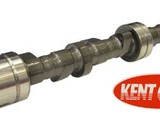|
Kent Cam Timing: |
|||
|
There are a number of different methods of cam timing. We at Kent Cams use either the 'Lift at Top Dead Centre' method, or the 'Full Lift Position method' Full Lift Position method: For many years the most commonly used method has involved establishing top dead center (TDC) as a datum (zero degrees) and positioning your camshaft with its inlet valve at maximum lift at a given position relative to this datum. |
|||
|
Lift at Top Dead Centre: In recent years with the proliferation of multi valve/multi cam engines this method can be a labourious hit and miss affair. This is solved by setting all of your camshaft timing at a specified lift at the previously used datum of TDC. |
|||
|
Basic fitting rules: |
|||
|
The installation and first few moments of running are critical factors in the life of the camshaft and the following instructions have been devised in order to obtain maximum performance from the engine and to ensure a long and trouble free life from both the camshaft and associated components. These points are designed to be used in conjunction with the original manufacturers installation procedure.
Put simply they are manufacturers of all types camshafts, specialising in motorsport, short production runs, pre production prototypes and one off’s, however their in house manufacturing expertise extends to valve retainers, adjustable cam pulley’s, valve guides, chain gears, poly-v belt pulley’s, cam followers and shims. They also offer a bespoke range of valve springs, FSE injection pumps and regulators and are also Europes largest ARP stockist. Established in the late 1970’s, Kent Performance Cams has grown from a fledgling idea nurtured by two engineers - Bob Munt and Bob Fry - into a world renowned specialist camshaft manufacturing team, a camshaft manufacturing house that was capable of producing competition engine components within strict quality control criteria whilst still remaining cost effective, a policy we still pursue to this day.Bob Fry - who took full control of the company in 1989 - has since taken a back seat in the running of the company leaving the existing management team - Tony Woodward, Andy Burns, Malcolm Hawkins and Graham Watts - as the primary Directors responsible for further growth of the company. Other key employees include Sales Manager Del Johnson, whose automotive experience spans thirty years. What Do We Do? Many people think of Kent Performance Cams as a company that just produces performance race cams, others think of us as manufacturers of tuned road cams. The truth however is nearer the former - Our original remit was based on offering motorsport engine builders a cost effective design and production facility with short lead times. As our name became synonymous with some of the most regarded names within the industry, our customer portfolio soon grew. Our experience solely in the performance engine tuning industry helps confirm our position as the leading designer and manufacturer of motorsport camshafts in Europe. Engineers who produced cams for turbo F1 engines and Gp‘B’ Rally cars now create cams that are currently used in CART engines, World Rally Cars, World Superbikes and MotoGP. In virtually every form of motorsport from Offshore power boats to Touring Cars, Rallycross to WRC there are competitors currently benefiting from our influence. Our manufacturing capability is constantly being updated, recent developments have involved expanding our factory/head office a further 5000 square feet, and the installation of a new CNC cam machining centre and CNC Grinding Centre. |


 Who Is Kent Camshafts
Who Is Kent Camshafts





